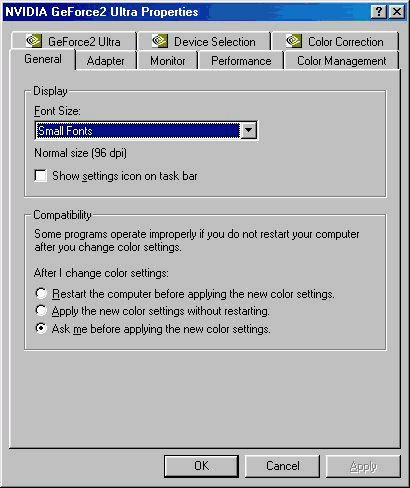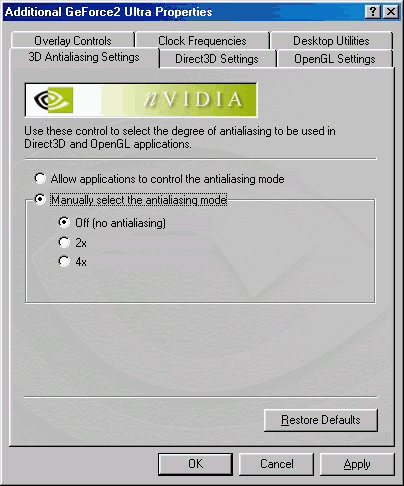Elsa Geforce 2 Ultra
Elsa have a long tradition of making high performance graphics cards. I reviewed some of their other GeForce2 offerings back in late 2000, here I'm looking at the GeForce2 Ultra, the fastest GeForce2 series card that is made. It has 64MB of 3.8ns DDR memory running at 460MHz DDR, backed up by the GeForce2 Core running at 250MHz, and all packaged together with some fairly large green heatsinks, there is unfortunately no TV Output as standard on the Gladiac Ultra, although this is available, on an optional TV out module. There are lots of articles on the GeForce2 core architecture and T&L, already out there on the net, so here I'll be just looking at how it all works.
Test Rig
| Soltek SL 75- KAV KT133A chipset | ||||
| 384MB Crucial PC133 RAM CAS 2 | ||||
| AMD Athlon T-Bird @ 1333MHz | ||||
| IBM GXP 75 30 gig | ||||
| Soundblaster Live 1024 | ||||
| Adaptec SCSI Card | ||||
| Plextor 40 Speed SCSI CD ROM | ||||
| 19" CTX monitor | ||||
| Microsoft Intellimouse Explorer Optical | ||||
| Microsoft Natural Keyboard | ||||
Running Win98 SE with Via Service Pack 4.31a, AGP 4* enabled 128MB AGP Aperture Nvidia Detonator 12.60
The Hardware



Well that's enough of the greenery lets see how well it performs.
The Specs
| NVIDIA GeForce2 Ultra, processor speed: 250 MHz | |||
| Memory outfit | 64-MB DDR SDRAM, 4 ns access time, 460 MHz effective memory cycle | ||
| RAMDAC/pixel cycle | 350 MHz | ||
| BIOS | VESA-BIOS-3.0-Support | ||
| Bus-System | AGP2x/4x, Fast Writes | ||
| Features | |||
| Graphics standards | Direct3D, OpenGL, DirectX7, DirectDraw, DirectShow | ||
| 2D features | 256-bit 2D acceleration, optimized for 32, 24, 16, 15, and 8-bit color depths, hardware cursor in TrueColor, multi-buffering (2x, 3x and 4x for flowing movement and video playback) | ||
| 3D Features | 256-bit engine with HyperTexel architecture, optimized Direct3D and OpenGL acceleration, full DirectX7 support, 32-bit Z and stencil buffer, single-pass multi-texturing, anti-aliasing, high-quality texture filtering, including anisotropic; advanced per-pixel texturing for perspective correction, fog and depth cueing, texture compression | ||
| HDTV- und DVD-Playback | Extended motion
compensation for full screen video playback in all DVD and HDTV resolutions, video acceleration for MPEG-1, MPEG-2 and Indeo |
||
| TV-out (optional) | Connection for S
video and Composite/FBAS (with included adapter); PAL (max. 800 x 600 pixels), NTSC (max. 640 x 480 pixels) |
||
| Standards | DPMS, DDC2B, Plug&Play | ||
| Connectors | Monitor:
VGA-D-Shell (15polig) TV-out (optional): mini DIN (4-pin), Cinch using included adapter |
||
| Dimensions | 173 x 108 mm (ATX format, not including mounting bracket) | ||
Installation
As always I installed the graphics card along with a fresh install of Windows. The GeForce graphics cards all use the same drivers, having just been using Detonator 12.60 with a GeForce3, I chose to use the same drivers for this review, Installation was simply a matter of putting the card in and then browsing to the correct directory. Directx 8 was also installed to run the Directx 8 benchmarks.
Control Panels


Benchmarks
As this is the first GeForce2 card that I've reviewed in a while it is somewhat tricky to decide, what I should use as a baseline. I decided on comparing it with some different cards, the GeForce2 MX which I reviewed a while ago, the Kyro II and GeForce3 for some of the benchmarks. This maybe not be a particularly fair comparison, but it does show how the Ultra stacks up against currently available hardware
Vulpine GL Mark 1.1
Vulpine GL Mark is a free download from, http://www.vulpine.de/ its around 39MB. The benchmark takes quite a while to run, but it does run some pretty nifty graphics. The benchmark also has options specifically for the GeForce3, but these are greyed out when a GeForce2 is installed, so I ran the default benchmark and chose full screen setting.
1024*768*32bit Full screen Standard OpenGL 1.2, Texture Compression on, High Detail
| Vulpine GLMark | Ultra |
| min | 19 |
| max | 147 |
| average | 37.4 |

GLMark obviously stresses the Geforce2 Ultra out quite a bit, the minimum framerate gets down to 19FPS. The Ultra is the fastest card around for this particular benchmark besides the GeForce3 which is quite a bit faster.
Quake 3
Here's the obligatory Quake 3 benchmarks, this time showing the performance against some widely available cards, namely the Kyro II, GeForce2 MX, GeForce2 Ultra and the latest the GeForce3
| Quake 3 Demo 1 | 640*480 | 800*600 | 1024*768 | 1280*1024 | 1600*1200 |
| EHQ KYRO2 | 127.1 | 120.9 | 97.1 | 59.3 | 40.1 |
| EHQ MX | 122.9 | 88.4 | 56.5 | 33.9 | 20.7 |
| EHQ Ultra | 141.1 | 139.2 | 115.7 | 74.4 | 51.5 |
| EHQ GF3 | 141.2 | 139.5 | 128.2 | 93.6 | 66.2 |

Well there you have it the performance of a few of the currently available cards, as you can see the GeForce2 Ultra in green on the graph is only just behind the GeForce3, the GeForce2 MX is trailing in the higher resolutions. The Kyro II puts up a good performance against the other cards but ultimately the GeForce3 wins.
3DMark 2001
This is the benchmark everyone's talking about this year, although again its got some GeForce3 only features, it give any graphics card a good workout. The Lobby scene in 3Dmark features the same game engine and graphics as Max Payne a game that's due out later this year. So any way without further ado here are the results.
| 3DMark 2001 | 640*480 | 800*600 | 1024*768 | 1280*1024 | 1600*1200 |
| GF3 | 5571 | 5371 | 4887 | 4140 | 3331 |
| GF2 Ultra | 4601 | 4420 | 4011 | 3202 | 2461 |
| Kyro II | 2389 | 2383 | 2331 | 2176 | 1921 |

All 3 of the graphics card where benched the same at 1333MHz, the nature test was disabled for the GeForce3 as this counts towards the final score, the Kyro II and GeForce2 Ultra cannot run the Nature test so it is skipped by default. As you can see the GeForce3 pulls ahead, the Kyro II gets left in the dust by both the GeForce's.
Unreal Tournament
I ran Unreal Tournament, and benchmarked with the Thunder Demo, all detail settings where on high in 32 bit running in D3D mode.
| Unreal Tournament | 640*480 | 800*600 | 1024*768 | 1280*1024 |
| GeForce2 Ultra | 99.9 | 97.82 | 94.57 | 86.89 |

Basically with the GeForce Ultra you can play UT in any resolution you want, it works fine with all the settings maxed out on this 1.33GHz PC.
2D Performance
I had no problems with 2D performance, including DVD and DivX playback, 2D performance as far as I'm concerned is very good on all the current Nvidia GeForce based cards, and will allow you to run any application you should wish to.
Video Mark 2001
| Video Mark 2000 |
GeForce2 Ultra |
| Video Mark | 2152 |
| Quality | 780 |
| Performance | 772 |
| Features | 600 |
Overclocking
The GeForce Ultra is already clocked at 250MHz core 460MHz memory so its already running pretty darn fast at default settings. There is always the option to tweak the performance a bit more with the use of "coolbits" reg file, it allows you to adjust the speed of the core and memory. I'm sure everyone reading this is familiar with coolbits by now so I wont bore you with a screen shot. I managed to get the Elsa up to 300 Core and 520 memory. At those settings Quake 3 would run but there where quite a few graphics glitches on the screen, when I tried 3DMark 2001, it just locked up straight away, I backed the card down and it found that it ran stably at 275MHz Core 495MHz mem.
I ran 3DMark 2001 again with the card overclocked to show the gains that can be made, although not much, the extra performance is a free upgrade, which cant be bad (O:
| 3DMark 2001 OC | 640*480 | 800*600 | 1024*768 | 1280*1024 | 1600*1200 |
| GeForce 2 Ultra | 4601 | 4420 | 4011 | 3202 | 2461 |
| GeForce 2 Ultra OC | 4632 | 4439 | 4200 | 3391 | 2669 |

Conclusion
The Elsa Gladiac GeForce2 Ultra, is a very good gaming card, it runs pretty much every current game with the detail settings maxed out, obviously it's lacking the features of its new big Brother the Gladiac 920 GeForce3, but the Ultra sells at a much more reasonable price. As such its definitely a good buy. Since it was released the GeForce2 Ultra has dropped considerably in price, as Elsa cards are already priced very competitively, now is probably a very good time to upgrade from that old Voodoo3, that just isn't up to the job these days. The GeForce2 Ultra leaves the MX based cards standing in terms of high resolution gaming, and as the 32MB GeForce2 GTS is becoming increasingly rare the Ultra is the card in the middle sandwiched between the MX and the GeForce3. Right now there are very few games that support the GeForce3 features, in a years time the story will be very different, but right now the Gladiac Ultra will play just about all the games and run all the applications that you could possibly need.
If you crave the ultimate in speed then look at the Elsa Gladiac 920, as it is one of the best priced GeForce3's around, if just plain very fast will do then make sure you look at this card the Gladiac Ultra. With street prices around £220 for the Gladiac Ultra, it is around £80 less than the Gladiac GeForce3, the decision is yours.













